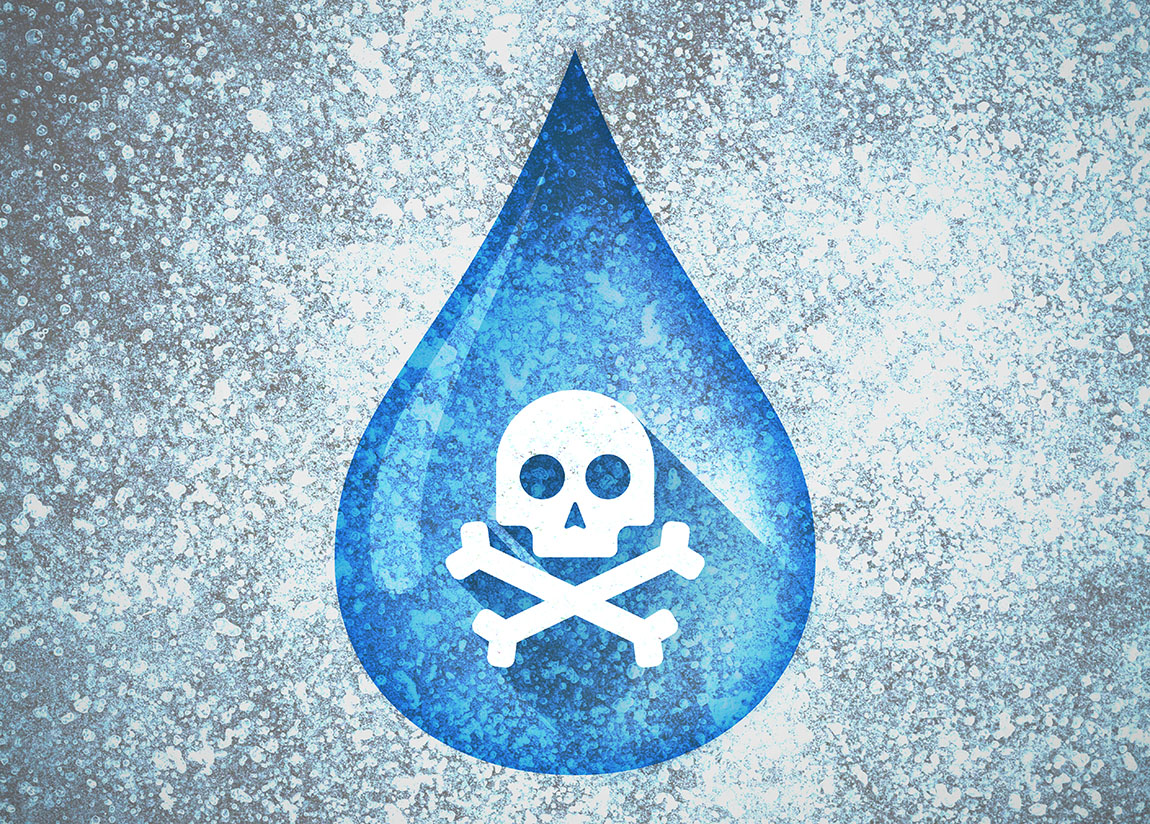The Most Important Toxic Exposure of Our Generation
The Environmental Protection Agency is proposing rules to mitigate a group of dangerous chemicals that can be found throughout the environment, including in our drinking water.By: Michael Petriello ’10 Monday, July 17, 2023 10:03 AM
 Illustration by iStock.com/Blablo101
Illustration by iStock.com/Blablo101In March, the Environmental Protection Agency proposed the first regulations on the concentration of certain per- and polyfluorinated alkyl substances (PFAS) in drinking water. I am a toxicologist who studies the cardiovascular effects of exposure to PFAS, and I believe that this is the most important toxic exposure our generation is experiencing. Studies show that 98 percent of us, if not more, are exposed to some of these PFAS. They are ubiquitous in the environment.
PFAS are a class of thousands of different compounds that share a similar purpose: They’re good at keeping things from sticking to different materials. They’re used in the Teflon coatings on pans, to make fabric waterproof or stain-proof and in food packaging (like sandwich wrappers and microwave popcorn bags). Ingestion is the most common way these chemicals get into the human body, including through our drinking water. PFAS get into drinking water partly because this class of compounds — especially the ones that became widespread starting in the 1950s and have since been discontinued — are so resilient in the environment that we don’t even know how long it will take for them to break down. This is why PFAS are sometimes called “forever chemicals.” And unfortunately, typical home water filters are not very good at removing PFAS.
Once they’re in the human body, PFAS can circulate at a very high level. In our blood, PFAS concentration can be measured at parts per billion. Many other pollutants that people study are in the parts per trillion. Some of our own hormones aren’t even at the parts-per-billion level in our blood.
It is hard to study the cumulative risk of PFAS because there are so many of them. It’s even harder to know how different PFAS might interact with one another inside the human body to possibly increase toxicity. But if you look at epidemiological studies of PFAS, a few effects keep popping up. PFAS definitely impact the immune system. PFAS definitely increase cholesterol. There are definitely links between PFAS and certain types of cancers. Part of my lab is also looking at maternal exposures to PFAS, because they can cross the placenta and pass through breastmilk. We’ve exposed adult mice to PFAS and we see a strong perturbation of the gut microbiome, which is really important for child and adult health outcomes. When you keep looking at different disease endpoints, you see some effect of PFAS.
The proposed EPA regulations would fall under the Safe Drinking Water Act and require municipalities to monitor for six of the most common PFAS, including four that are no longer being produced in the United States. For the two most common of those, they’re setting a proposed Maximum Contaminant Level at four parts per trillion. That’s very, very low. PFAS may be one of those things, like with lead, that we never find a true “safe level,” but starting at four parts per trillion is great. The EPA could have set a higher threshold that would’ve been easier for municipalities to meet, but they used data from scientific studies to arrive at this level they thought would be safe. Like with other pollutants, these regulations will require public water systems to monitor for six PFAS, make the measured levels of these PFAS available to the public and reduce the levels of these PFAS if thresholds are exceeded. This may be scaring some municipalities right now — PFAS contamination can be very expensive to remediate. Thankfully, the Bipartisan Infrastructure Law earmarks between $2 billion and $5 billion to help, but reaching these low levels across the country will likely require additional investment.
The EPA regulations aren’t expected to be finalized until the end of this year. People always ask me what they can do to mitigate their risk other than reducing their exposure (throwing out their nonstick pans when they get scratched, for example, or avoiding clothing or packaging made with PFAS). There is no FDA-approved therapy to decrease your PFAS levels, but there are people out there, including those in my lab, who are actively looking at interventions beyond decreasing exposure.
What’s interesting about these compounds is they circulate in our blood very readily by binding to proteins and lipids in our blood. We just put out a paper where we looked at PFAS levels in an intervention study in Kentucky. The participants were trying to lower their cardiovascular risk through diet and exercise. What we saw is that they lowered their cholesterol, so the intervention worked, but their PFAS levels also went down. There’s also some evidence that fiber intake might decrease PFAS. Irrespective of the exact mechanism, having a healthy lifestyle will probably buffer against a lot of the toxic effects of PFAS. It’s amazing that these regulations are in process at the government level, but we always want to be able to tell people what they can do personally, as well.
Michael Petriello ’10, who was an environmental science and biology double major at Muhlenberg, is an assistant professor in the Institute of Environmental Health Sciences at Wayne State University in Detroit.
